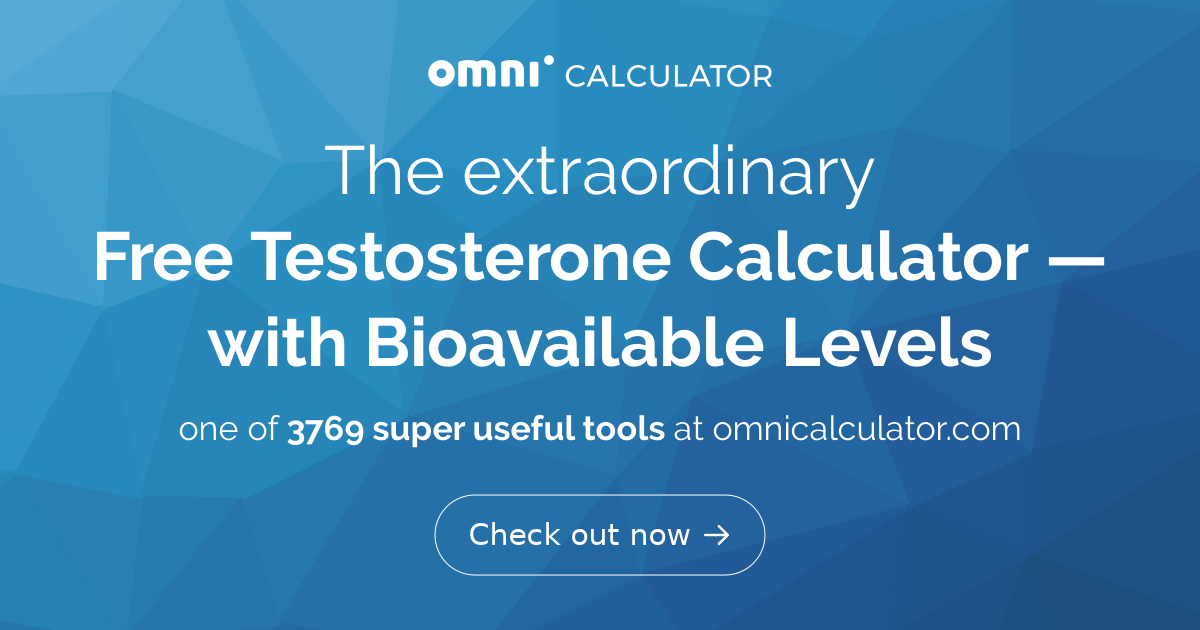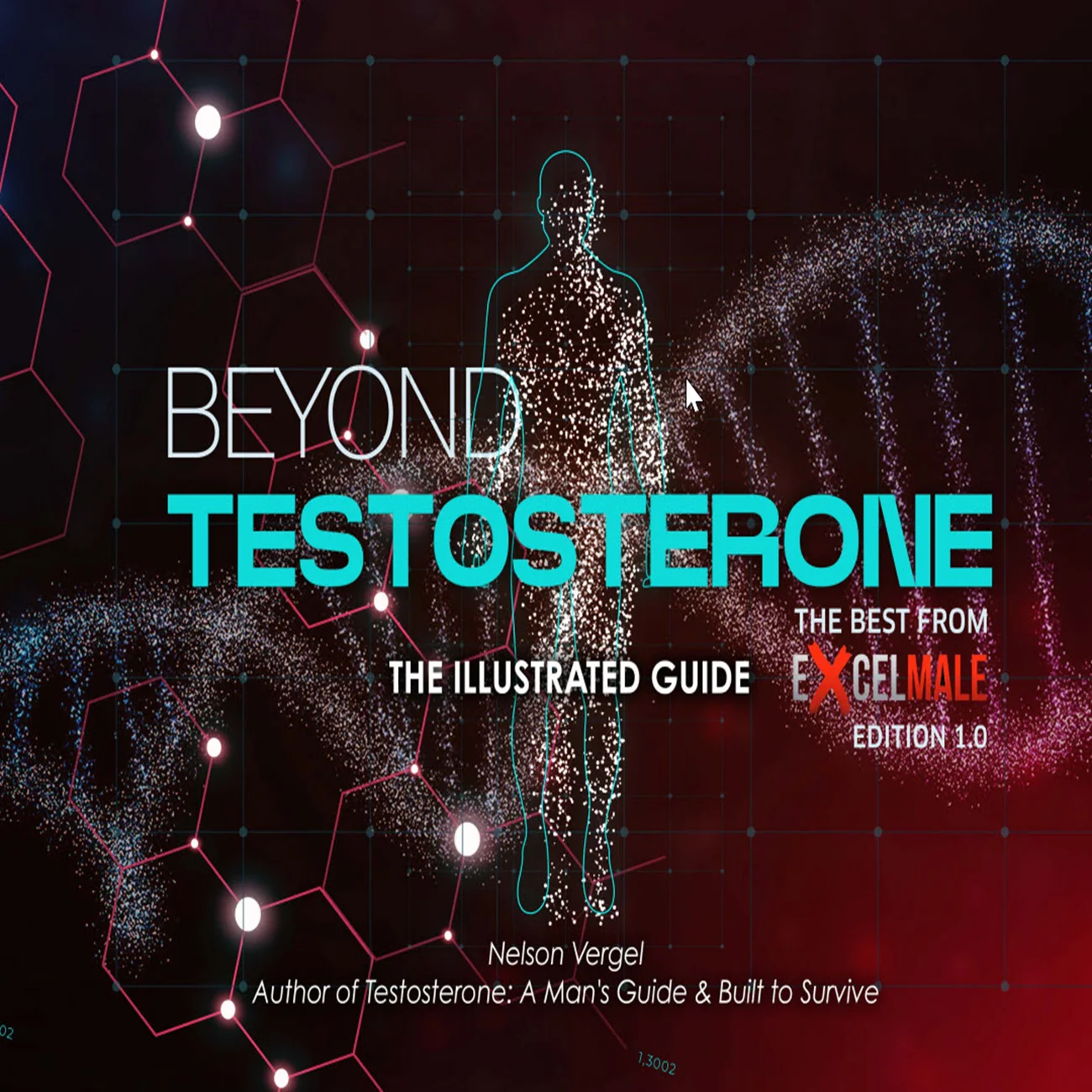You should upgrade or use an alternative browser.
what is the 2 % of Total Test
- Thread starter TRT1986
- Start date
-
- Tags
- testosterone
Systemlord
Member
You would need the TT, SHBG and the Albumin to be able to calculate the FT in the first place.say Total Test is 800 ng/dl and FT is in pg/ml?
Tru-T calculator
thanks for replying. I'm asking as I'm doing more and more reading, I see that in the studies and also by watching some videos, Total testosterones is always mentioned.You would need the TT, SHBG and the Albumin to be able to calculate the FT in the first place.
Tru-T calculator
Example, in a video I just watched, it was said that to build muscle we need at least 750 to 800 of TT, and going over 1000 may potentially pose some health risk on the long term.
My SHBG is low, so this ratio is screwed up, if I would go by TT my FT would need to go way above reference range, so I believe I should go for a FT range rather than TT range, does it make sense?
Systemlord
Member
YouTube isn’t a good place to get accurate information, content creators need views to get compensation. None of the above quote is true for everyone, it’s a generalized statement with no real accuracy.Example, in a video I just watched, it was said that to build muscle we need at least 750 to 800 of TT, and going over 1000 may potentially pose some health risk on the long term.
That’s like saying everyone needs the same diet. Some men aren’t even built for high testosterone and midrange is normal for them.
A guy came to Excelmale years ago, was in his prime, no issues, he was quite muscular and scored a TT at 158. Some guys can handle 1500> without issues long term, some men can’t.
Some men can abuse testosterone their entire life without damaging their natural production, some go on their first cycle and ruin their natural production.
We are not born equal. Getting good DNA is like playing poker, sometime you get a really good hand and other times you get dealth a bad hand.
Systemlord
Member
You have to experiment and find out what works for you. I know this is tough to hear, but TRT doesn’t work for everyone.My SHBG is low, so this ratio is screwed up, if I would go by TT my FT would need to go way above reference range, so I believe I should go for a FT range rather than TT range, does it make sense?
The calculation is correct, but the units remain the same, so it's 16 ng/dL. Multiply by 10 to get pg/mL—160 pg/mL. However, don't expect sensible comparisons with some lab tests. The direct immunoassay tests in particular are inaccurate and their reference ranges usually have little connection to actual hormone concentrations.I'm understanding that let SHBG alone, free testosterone should be 2% of total, how do we calculate that? let's say Total Test is 800 ng/dl and FT is in pg/ml? 800 x 0,02 = 16?
You are correct. Free testosterone's fraction of total is not particularly meaningful. Concentrate on free testosterone—either measured accurately by equilibrium dialysis or else calculated using the Vermeulen method. A healthy target range for the latter is about 10-20 ng/dL....
My SHBG is low, so this ratio is screwed up, if I would go by TT my FT would need to go way above reference range, so I believe I should go for a FT range rather than TT range, does it make sense?
madman
Super Moderator
You would need the TT, SHBG and the Albumin to be able to calculate the FT in the first place.
Tru-T calculator
For the time being, would not even waste your time trying to push this on here!
PHASE IIB is the next hurdle.
I spoke with Bhasin and let's just say there is much more to come.
This is not going away anytime soon.
Giving you a big heads-up.
Take notice of the key points I highlighted!
*This application follows the FDA’s published “Guidance for Industry: Bioanalytical Method Validation”
*The essential parameters to determine the acceptability of a bioanalytical method include its technical performance (accuracy, precision, sensitivity, selectivity, stability, and matrix effects)
*Reference ranges should be determined in appropriate human samples.
*The analytical method should be validated for the intended use (e.g., determination in conditions of intended use, such as persons with altered E2 and T levels, women with PCOS, TGD persons, etc.).
post #132
Phase IIB: Development of TruT Algorithm for Commercialization in Androgen Disorders (2022)
TruTTM (v2.0) algorithm
ABSTRACT
Background: Measurement of free testosterone (T) concentrations is indicated in the diagnosis of androgen disorders, including hypogonadism in men; hirsutism, polycystic ovary syndrome (PCOS), and androgenic alopecia in women; pubertal disorders in boys and management of gender-affirming hormone therapies for transgender and gender diverse (TGD) persons. This Phase IIB proposal aims to continue the development of the TruTTM algorithm by validating it in common conditions characterized by altered estradiol (E2), T, and SHBG concentrations and incorporating the interaction of E2 with T for wider commercial adoption in women in whom E2 levels vary greatly across the menstrual cycle and in TGD population.
Approach: This application follows the FDA’s published “Guidance for Industry: Bioanalytical Method Validation”.
The essential parameters to determine the acceptability of a bioanalytical method include its technical performance (accuracy, precision, sensitivity, selectivity, stability, and matrix effects).
Reference ranges should be determined in appropriate human samples.
The analytical method should be validated for the intended use (e.g., determination in conditions of intended use, such as persons with altered E2 and T levels, women with PCOS, TGD persons, etc.).
In studies through the Phase II, we demonstrated that the method has superior performance characteristics and extended the validation of TruTTM algorithm in conditions characterized by altered SHBG concentrations.
*In the proposed Phase IIB studies, we will generate the v2.0 of TruTTM algorithm by incorporating the dynamics of the E2 induced perturbation in free T levels, validate it in men, women, and TGD populations (Aim 1) and deploy HIPAA-compliant, secure integration of the algorithm into electronic medical records (EMR) workflow
*(Aim 2). Future Directions and Commercialization potential: The phase IIB program will enable the pilot commercial deployment of a HIPAA-compliant (FDA registered) platform for commercializing the TruTTM (v2.0) algorithm embedded into electronic medical record (EMR) for wider clinical adoption.
These studies will improve clinical care and advance our fundamental understanding of dynamic regulation of T bioavailability in diverse populations including unrepresented sexual and gender minorities.
tareload
Guest
Thank you for the honest appraisal. A couple more days I will have some data to share. I hope you are well.For the time being, would not even waste your time trying to push this on here!
tareload
Guest
cFTv still winning.
madman
Super Moderator
I'm understanding that let SHBG alone, free testosterone should be 2% of total, how do we calculate that? let's say Total Test is 800 ng/dl and FT is in pg/ml? 800 x 0,02 = 16?
Look over this thread!
Testosterone fractions in blood? - Excel Male Health Forum
thanks, indeed looking at my labs (LabCorp) I have always tested FT with direct method, the scale is 8.7 - 25.1 pg/ml. Understanding this is not the most accurate. how do I fit in in this scale 160 pg/ml? which should be the 2% of 800 ng/dl of TT? just divide by 10?The calculation is correct, but the units remain the same, so it's 16 ng/dL. Multiply by 10 to get pg/mL—160 pg/mL. However, don't expect sensible comparisons with some lab tests. The direct immunoassay tests in particular are inaccurate and their reference ranges usually have little connection to actual hormone concentrations.
You are correct. Free testosterone's fraction of total is not particularly meaningful. Concentrate on free testosterone—either measured accurately by equilibrium dialysis or else calculated using the Vermeulen method. A healthy target range for the latter is about 10-20 ng/dL.
thank youLook over this thread!

Testosterone fractions in blood? - Excel Male Health Forum
what is the typical % ranges for SHBG and albumin in regards to testosterone fractions in the blood? The image is one examaple but Every source I come accross says a different thing. We know that 98% is bound. 2% is free... of course the amount bound (SHBG/albumin) is going to be user specific...www.excelmale.com
In my opinion the direct test is so inaccurate that it should be ignored. Most of my Labcorp panels have included this test, so I've been able to compare it to calculated free testosterone by plotting against dose. The results are expected to be linear. The calculated free testosterone values, both Vermeulen and Tru-T, appear quite linear, with R^2 greater than 0.9. The direct test performs relatively poorly, with R^2 about 0.5.thanks, indeed looking at my labs (LabCorp) I have always tested FT with direct method, the scale is 8.7 - 25.1 pg/ml. Understanding this is not the most accurate. how do I fit in in this scale 160 pg/ml? which should be the 2% of 800 ng/dl of TT? just divide by 10?
If you're determined to make the comparison then I seem to recall that @readalot has posted a conversion factor.
tareload
Guest
In my opinion the direct test is so inaccurate that it should be ignored. Most of my Labcorp panels have included this test, so I've been able to compare it to calculated free testosterone by plotting against dose. The results are expected to be linear. The calculated free testosterone values, both Vermeulen and Tru-T, appear quite linear, with R^2 greater than 0.9. The direct test performs relatively poorly, with R^2 about 0.5.
If you're determined to make the comparison then I seem to recall that @readalot has posted a conversion factor.
Public Service Announcement: "Piss Poor" Direct RIA fT measurement (HELP is on the way) - Excel Male Health Forum
I'll have a recent example soon.

Free Testosterone Calculator — with Bioavailable Levels
Use this calculator and it’s very accurate to my actual labs. It had my last one 25 over and 5 others the same. My guess is the labs use 4.3 as Albumin
tareload
Guest
See Parts I and II (thread attached)
Public Service Announcement: "Piss Poor" Direct RIA fT measurement (HELP is on the way) - Excel Male Health Forum
Hey Folks, thought I would update the graph for free T reference ranges based on LC-MS/MS+ED and compare with Labcorp's direct RIA fT reference range. What the hell do you do with with your direct fT measurement if you want to compare with equibrium dialysis reference ranges? Take the...www.excelmale.com
I'll have a recent example soon.
madman
Super Moderator
For the time being, would not even waste your time trying to push this on here!
PHASE IIB is the next hurdle.
I spoke with Bhasin and let's just say there is much more to come.
This is not going away anytime soon.
Giving you a big heads-up.
Take notice of the key points I highlighted!
*This application follows the FDA’s published “Guidance for Industry: Bioanalytical Method Validation”
*The essential parameters to determine the acceptability of a bioanalytical method include its technical performance (accuracy, precision, sensitivity, selectivity, stability, and matrix effects)
*Reference ranges should be determined in appropriate human samples.
*The analytical method should be validated for the intended use (e.g., determination in conditions of intended use, such as persons with altered E2 and T levels, women with PCOS, TGD persons, etc.).
post #132
Phase IIB: Development of TruT Algorithm for Commercialization in Androgen Disorders (2022)
TruTTM (v2.0) algorithm
ABSTRACT
Background: Measurement of free testosterone (T) concentrations is indicated in the diagnosis of androgen disorders, including hypogonadism in men; hirsutism, polycystic ovary syndrome (PCOS), and androgenic alopecia in women; pubertal disorders in boys and management of gender-affirming hormone therapies for transgender and gender diverse (TGD) persons. This Phase IIB proposal aims to continue the development of the TruTTM algorithm by validating it in common conditions characterized by altered estradiol (E2), T, and SHBG concentrations and incorporating the interaction of E2 with T for wider commercial adoption in women in whom E2 levels vary greatly across the menstrual cycle and in TGD population.
Approach: This application follows the FDA’s published “Guidance for Industry: Bioanalytical Method Validation”.
The essential parameters to determine the acceptability of a bioanalytical method include its technical performance (accuracy, precision, sensitivity, selectivity, stability, and matrix effects).
Reference ranges should be determined in appropriate human samples.
The analytical method should be validated for the intended use (e.g., determination in conditions of intended use, such as persons with altered E2 and T levels, women with PCOS, TGD persons, etc.).
In studies through the Phase II, we demonstrated that the method has superior performance characteristics and extended the validation of TruTTM algorithm in conditions characterized by altered SHBG concentrations.
*In the proposed Phase IIB studies, we will generate the v2.0 of TruTTM algorithm by incorporating the dynamics of the E2 induced perturbation in free T levels, validate it in men, women, and TGD populations (Aim 1) and deploy HIPAA-compliant, secure integration of the algorithm into electronic medical records (EMR) workflow
*(Aim 2). Future Directions and Commercialization potential: The phase IIB program will enable the pilot commercial deployment of a HIPAA-compliant (FDA registered) platform for commercializing the TruTTM (v2.0) algorithm embedded into electronic medical record (EMR) for wider clinical adoption.
These studies will improve clinical care and advance our fundamental understanding of dynamic regulation of T bioavailability in diverse populations including unrepresented sexual and gender minorities.
@Nelson Vergel
All my threads that I invested so much time in are missing?
Post #132
hCG Mixing Calculator
HCG Mixing Protocol Calculator
Similar threads
- Replies
- 4
- Views
- 6K
TRT Hormone Predictor
Predict estradiol, DHT, and free testosterone levels based on total testosterone
⚠️ Medical Disclaimer
This tool provides predictions based on statistical models and should NOT replace professional medical advice. Always consult with your healthcare provider before making any changes to your TRT protocol.
ℹ️ Input Parameters
Predicted Hormone Levels
Enter your total testosterone value to see predictions
Results will appear here after calculation
Understanding Your Hormones
Estradiol (E2)
A form of estrogen produced from testosterone. Important for bone health, mood, and libido. Too high can cause side effects; too low can affect well-being.
DHT
Dihydrotestosterone is a potent androgen derived from testosterone. Affects hair growth, prostate health, and masculinization effects.
Free Testosterone
The biologically active form of testosterone not bound to proteins. Directly available for cellular uptake and biological effects.
Scientific Reference
Lakshman KM, Kaplan B, Travison TG, Basaria S, Knapp PE, Singh AB, LaValley MP, Mazer NA, Bhasin S. The effects of injected testosterone dose and age on the conversion of testosterone to estradiol and dihydrotestosterone in young and older men. J Clin Endocrinol Metab. 2010 Aug;95(8):3955-64.
DOI: 10.1210/jc.2010-0102 | PMID: 20534765 | PMCID: PMC2913038
Online statistics
- Members online
- 2
- Guests online
- 190
- Total visitors
- 192












